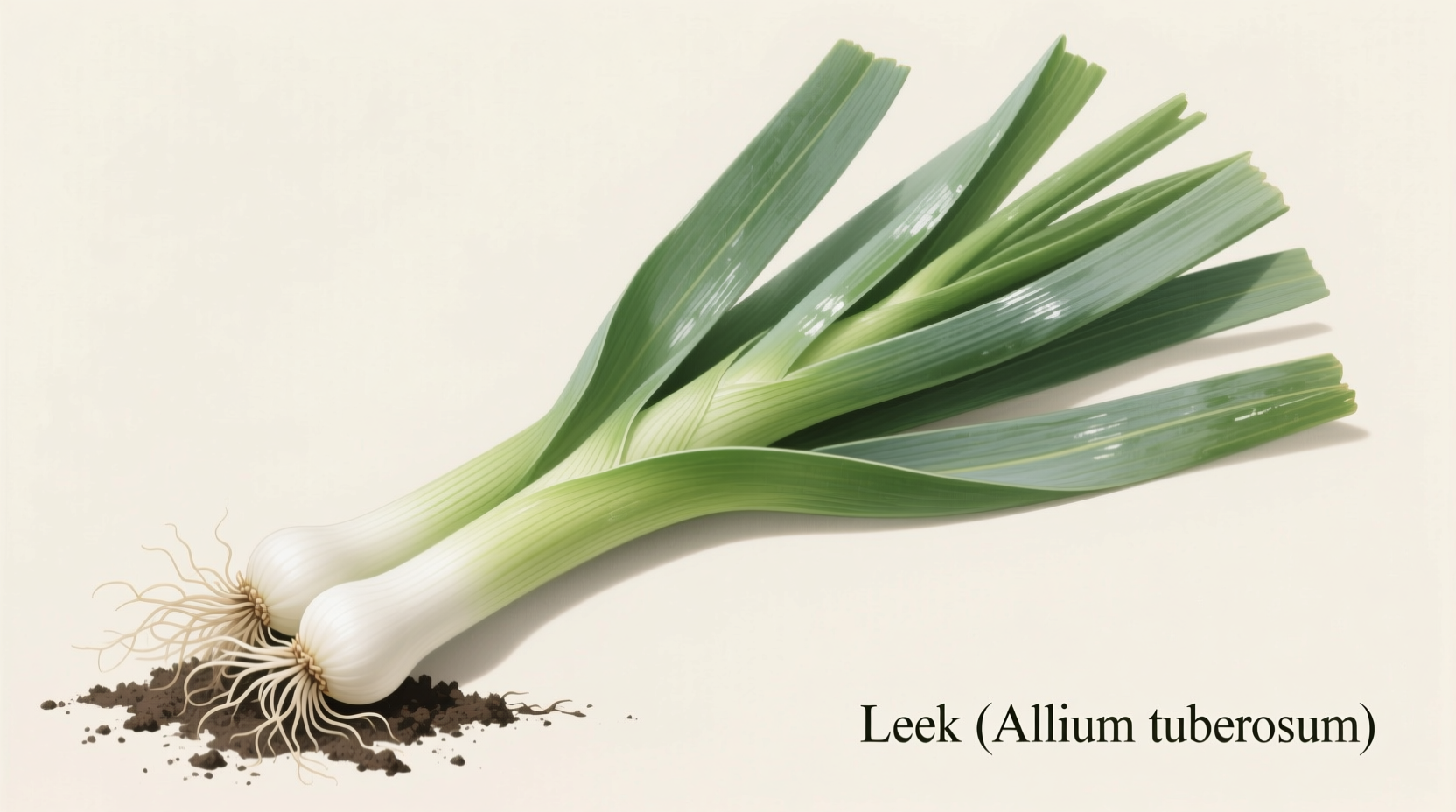Ever stood in the produce section wondering what does the vegetable leek look like compared to green onions or scallions? You're not alone. This common kitchen confusion happens daily as shoppers try to identify this versatile allium. Let's solve this visual puzzle once and for all with clear identification markers you can use immediately.
First Glance: Recognizing a Leek at the Market
When you approach the vegetable display, look for these distinctive features that answer what does the vegetable leek look like in its natural state:
- Height and shape: Typically 12-18 inches tall with a straight, cylindrical form tapering slightly from base to top
- Color gradient: A smooth transition from pure white at the root end through pale green to deep blue-green at the leaf tips
- Structure: Multiple concentric layers visible at the cut base, unlike the single bulb of an onion
- Texture: Firm, crisp feel with no soft spots or sliminess
Unlike its allium cousins, the leek maintains this elongated shape without forming a tight bulb. The white portion is actually a collection of overlapping leaf sheaths rather than a true bulb.

Close Examination: Breaking Down Leek Anatomy
To properly identify what does the vegetable leek look like up close, examine these specific components:
The White Base (Bulb)
This isn't actually a bulb like an onion's but rather tightly wrapped leaf bases. When cut crosswise, you'll see concentric circles rather than distinct layers. The white section should feel firm and solid, not hollow or mushy.
The Light Green Transition Zone
This middle section is where the color shifts from white to green. It's completely edible and often the most tender part. Many cooks mistakenly discard this portion, but it contains excellent flavor and texture.
The Dark Green Tops
While too fibrous for most raw applications, these dark green leaves aren't waste! They contain intense flavor perfect for stocks, soups, and broths. When identifying leeks, note that vibrant dark green tops indicate freshness.
Leek vs. Similar Vegetables: The Visual Comparison
Understanding what does the vegetable leek look like requires knowing how it differs from look-alikes. Here's how to tell them apart:
| Vegetable | Key Visual Differences | Size Comparison |
|---|---|---|
| Leek | Gradual color transition, wider diameter, no distinct bulb separation | 1-2 inches diameter at base, 12-18 inches tall |
| Green Onion/Scallion | Sharp color division between white and green, much thinner | ¼-½ inch diameter, 8-10 inches tall |
| Ramps/Wild Leeks | Broad flat leaves, reddish-purple stem base | Smaller, more delicate appearance |
| Shallot | Distinct clustered bulbs, coppery skin | 1-2 inch bulbs, not elongated |
Practical Identification Tips for Shoppers
Now that you know what does the vegetable leek look like, here's how to select the best ones:
- Check the base: Should be firm and white, not brown or slimy
- Examine the greens: Vibrant dark green indicates freshness (yellowing means age)
- Feel the texture: Should be crisp and firm throughout, not limp or rubbery
- Look for straightness: Curved leeks are often tougher and more fibrous
According to the USDA Agricultural Research Service, the most commonly available leek varieties in North American markets include Lincoln, King Richard, and Blue Solaise. While their appearance varies slightly, all share the characteristic elongated shape and color gradient that defines what does the vegetable leek look like.
Seasonal Changes in Leek Appearance
Understanding what does the vegetable leek look like throughout the year helps with proper identification:
- Spring leeks: Smaller diameter (about 1 inch), more tender, milder flavor
- Summer leeks: Medium size with balanced flavor profile
- Winter leeks: Largest (up to 2 inches), more robust flavor, often sweeter after frost
The Royal Horticultural Society notes that winter varieties like Blue Solaise develop a slightly bluish tinge to their leaves, which is perfectly normal and doesn't indicate spoilage. This seasonal variation is important context when determining what does the vegetable leek look like at different times of year.
Common Identification Mistakes to Avoid
Even experienced cooks sometimes confuse leeks with similar vegetables. Here's what to watch for:
- Mistaking large scallions for leeks: Scallions have a much sharper color division and are significantly thinner
- Confusing leeks with young elephant garlic: Elephant garlic has a more bulbous base and flatter leaves
- Discarding too much green: Only the very top 1-2 inches of dark green are typically too tough for most recipes
- Assuming all leeks are the same size: They range dramatically from pencil-thin spring varieties to thick winter specimens
Food safety experts at the FDA recommend proper identification of allium vegetables because misidentification could lead to using the wrong ingredient in recipes, potentially affecting both flavor and food safety in certain preparations.
Putting Your Knowledge to Work
Now that you can confidently identify what does the vegetable leek look like, put your knowledge to use:
- When shopping, look for leeks with crisp, unblemished leaves and firm white bases
- Store them upright in the refrigerator like flowers to maintain freshness
- Remember that the light green portion is completely edible and flavorful
- Use the dark green tops for homemade vegetable stock to reduce waste
Professional chefs consistently rate leeks as one of the most versatile alliums once properly identified. Their mild, sweet flavor works in everything from soups to roasts, making them worth the small effort to learn what does the vegetable leek look like in the produce section.











 浙公网安备
33010002000092号
浙公网安备
33010002000092号 浙B2-20120091-4
浙B2-20120091-4